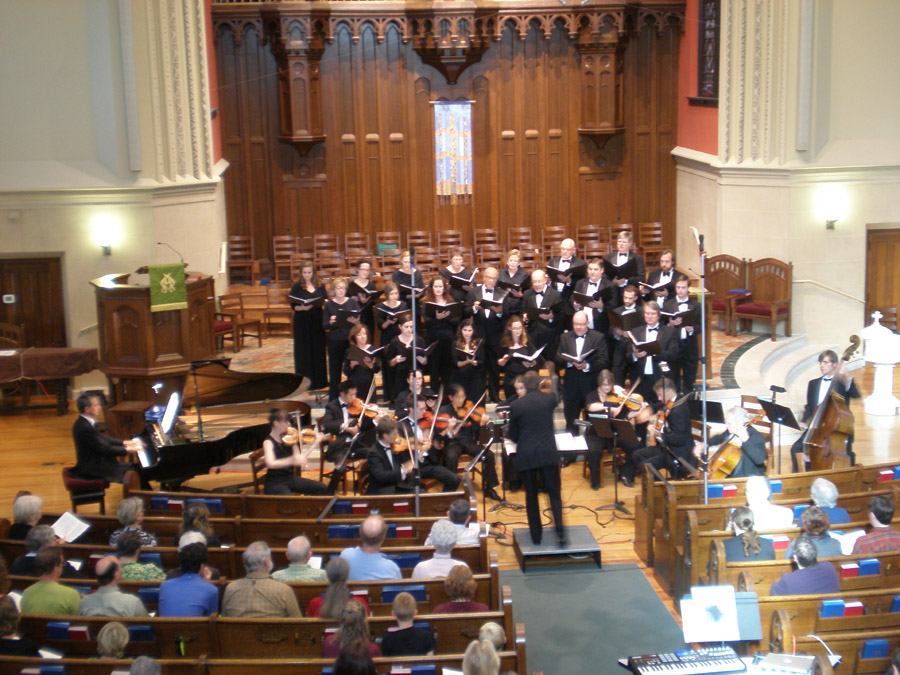
Mantra Cantata
(also for Chorus and Piano Quintet and Chorus, String Orchestra, and Piano)
(Nov. '08--Nov. '09) Traditional lyrics in Sanskrit and Hindi
In memory of my sister Akanda, and my guru Neem Karoli Baba
All documents are PDF.
*Full
Orchestral Score, Legal size
Cover
Orchestral
Parts
*Piano
Quintet and Chorus Score
String
Orchestra, Piano, and Chorus Score
String
Orchestral Score, 11"x17"
Vocal Score
Recordings from the October 21, 2012 premiere of the string orchestra and piano version with Rodney Wynkoop leading the Chamber Chorus of the Choral Society of Durham, Ciompi quartet as section leaders of the string orchestra, Randall Love on piano. Someday we'll perform the full orchestral version--somehow, somewhere, somewhen!
I. Om Jaya Jagadish Hare
II. Sri Ram Jai Ram Jai Jai Ram
Adagio raghunatha [6:44] video
III. Hanuman Chalisa
Allegro
vanara
[19:34] video
Program to October 21, 2012 premiere
performance
Also;
Recording of Sri Ram Jai Ram Jai Jai Ram from the January 13, 2012
premiere of the string orchestra and piano version, arranged
for Jewelsong
MP3 recording WAV recording video (YouTube)
Program Notes
I started chanting mantras in
about 1971, just before my first attempts at composition. This powerful
practice is central to my spiritual life, and inspires much of my music, both
instrumental and vocal. For some time I have intended to write a large work
based on my experiences with personal chanting, as well as sankirtan
(congregational chanting), but wanted to wait until I had experience and
opportunities for possible performance.
My own attention span is rather
long, and I enjoy many classical compositions lasting well over an hour.
However our modern times, and performance realities, dictate more modest
lengths. The three movements of this cantata could be augmented in the future
should more length be acceptable; or, maybe I’ll write another to use for a
double Bill.
The first movement, Om Jaya Jagadish
Hare, uses the text to the Universal Aarti. In Hinduism, Aarti is a
short ceremony in reverence to a deity or guru with a sung prayer and lighted
lamps of clarified butter.
The second movement uses the simple mantra Sri
Ram Jai Ram Jai Jai Ram, pronounced Shree Raam, Jay… It means
“Honored (or Radiant) Rama, Victorious Rama.” The double “aa” is as in
“father”.
The third movement is a setting of
the Hanuman Chalisa, a poem by Tulsidas in forty verses in praise of
Hanuman, the monkey devotee of Sri Rama. This is in the Avadhi dialect of
Hindi.
Performance Notes
I
have included a Sanskrit/Hindi pronunciation guide for use with the lyrics
printed before the score, which include diacritic marks to ensure complete
information on how the words sound when spoken by European scholars. I use an
anglicized spelling in the score and vocal part; this simplified pronunciation
is appropriate outside of India.
In every meter change,
except where indicated otherwise, the duration of notes remain the same.
It is characteristic of sankirtan to keep things
simple. I have limited the chorus to SATB, with one very brief exception in the
Hanuman Chalisa where each voice splits in two (mm. 281-284). In the
absence of choral forces, four singers could use amplification. For this case
at the split, the upper three voices should take the upper part and the bass
should sing the lower part. In any appropriate passage, the section can be
replaced by a soloist at the discretion of the choral director. The current
pattern of solo passages is as suggested by Rodney Wynkoop, conductor of the
premiere performance on October 21, 2012.
While there are challenges to performers, any
good college orchestra should be able to perform this piece. Professionals will
find plenty to keep them busy.
The double
bass part has excursions below low E. In all my orchestral scores, I write
notes down to low C with the same notes included an octave higher in case the
bassist does not have an extension or fifth string. It is important for this
piece that some basses can play the lower notes.
I have made revisions and format changes and
tweaks to parts and scores in October 2022.







